Understanding Why People Work: Factors Affecting Employee Motivation
VerifiedAdded on 2023/06/14
|8
|2073
|321
AI Summary
This report discusses the meaning of motivation, Maslow's hierarchy theory, positive and negative factors affecting employee motivation, and strategies to cope with negative factors. It also covers types of motivation and factors that motivate employees to work. The subject is Business Management, course code BMP3004, and the course name is World of Work. The report is relevant for BSc (Hons) Business Management with Foundation students.
Contribute Materials
Your contribution can guide someone’s learning journey. Share your
documents today.
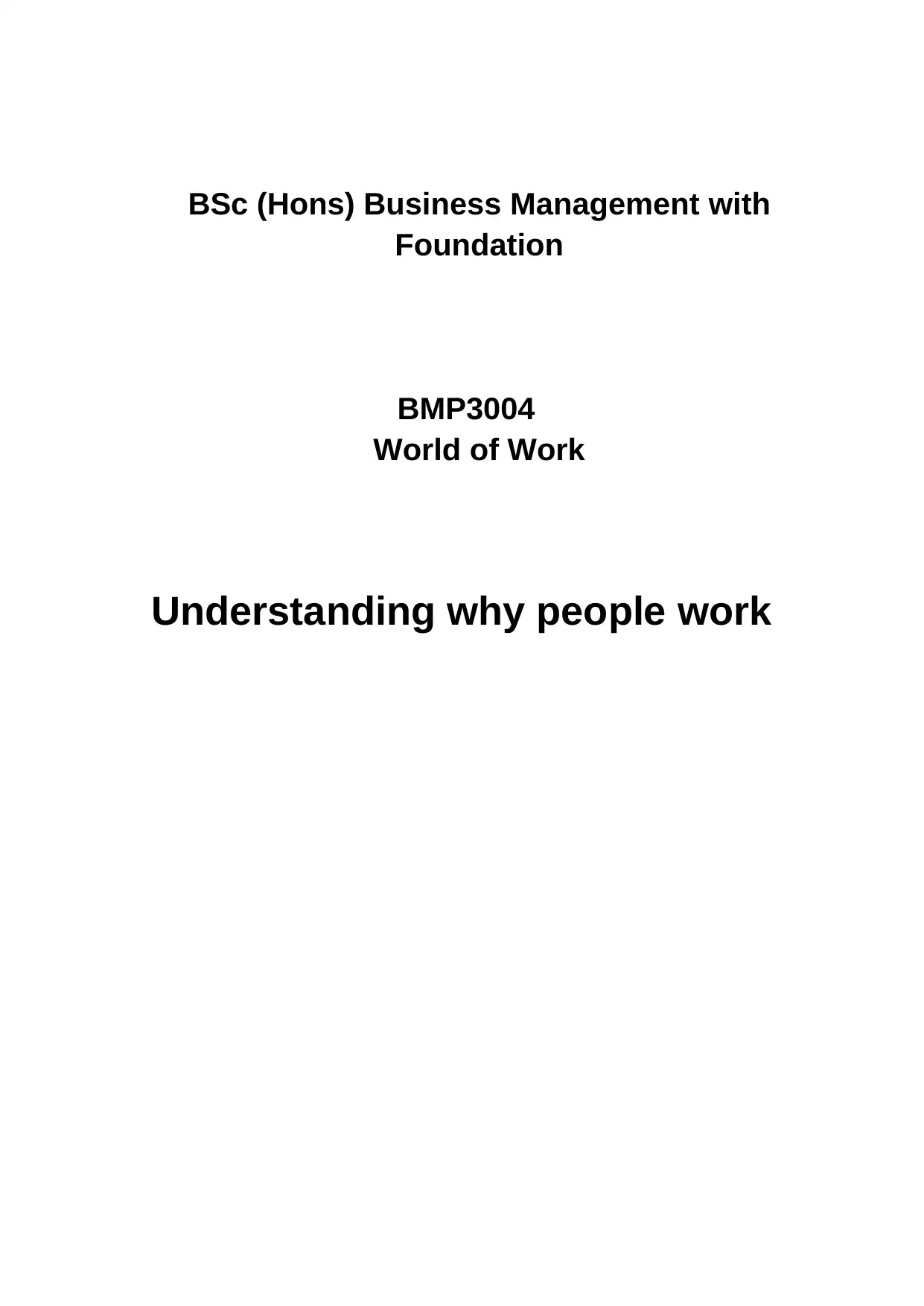
BSc (Hons) Business Management with
Foundation
BMP3004
World of Work
Understanding why people work
Foundation
BMP3004
World of Work
Understanding why people work
Secure Best Marks with AI Grader
Need help grading? Try our AI Grader for instant feedback on your assignments.
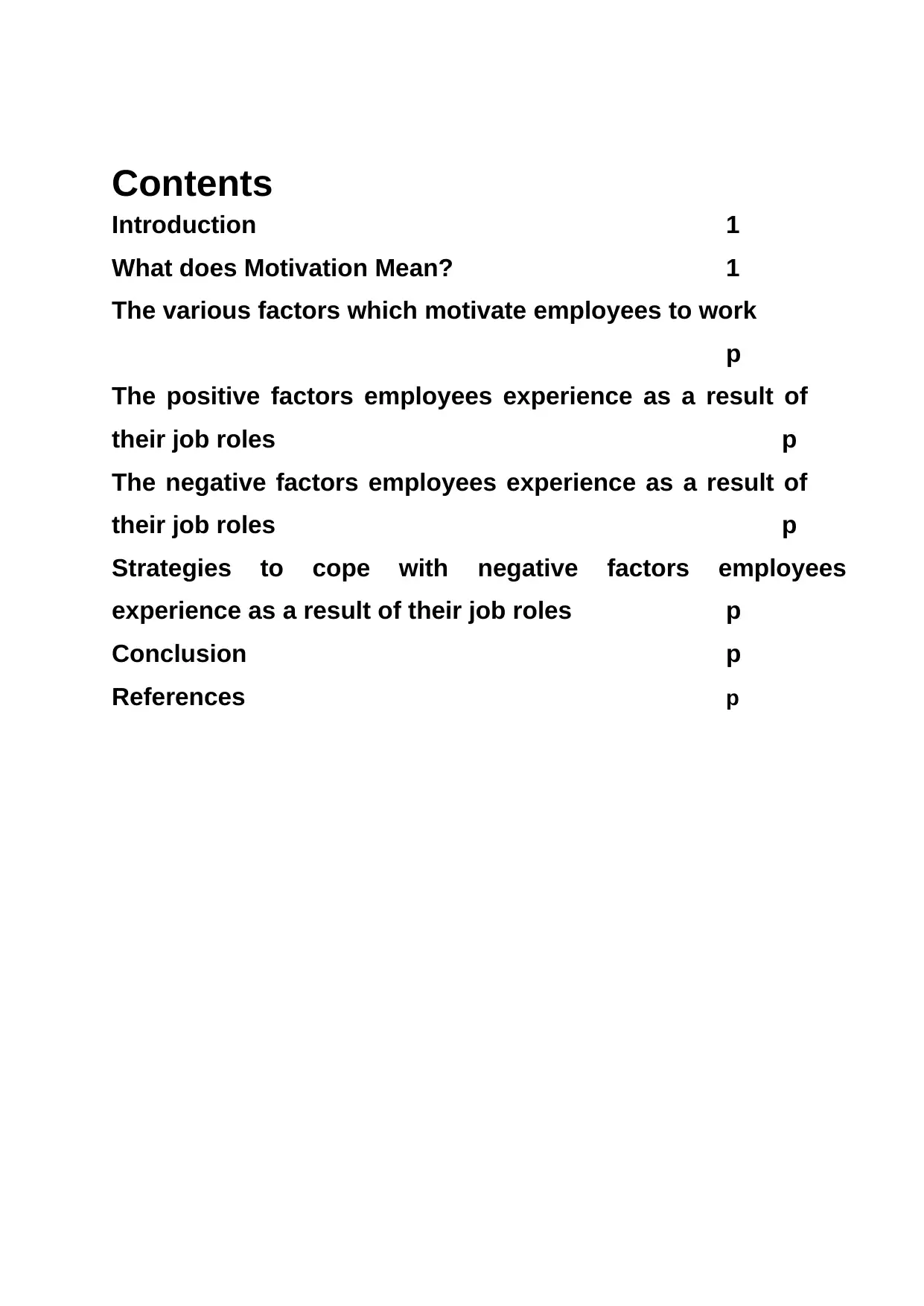
Contents
Introduction 1
What does Motivation Mean? 1
The various factors which motivate employees to work
p
The positive factors employees experience as a result of
their job roles p
The negative factors employees experience as a result of
their job roles p
Strategies to cope with negative factors employees
experience as a result of their job roles p
Conclusion p
References p
Introduction 1
What does Motivation Mean? 1
The various factors which motivate employees to work
p
The positive factors employees experience as a result of
their job roles p
The negative factors employees experience as a result of
their job roles p
Strategies to cope with negative factors employees
experience as a result of their job roles p
Conclusion p
References p
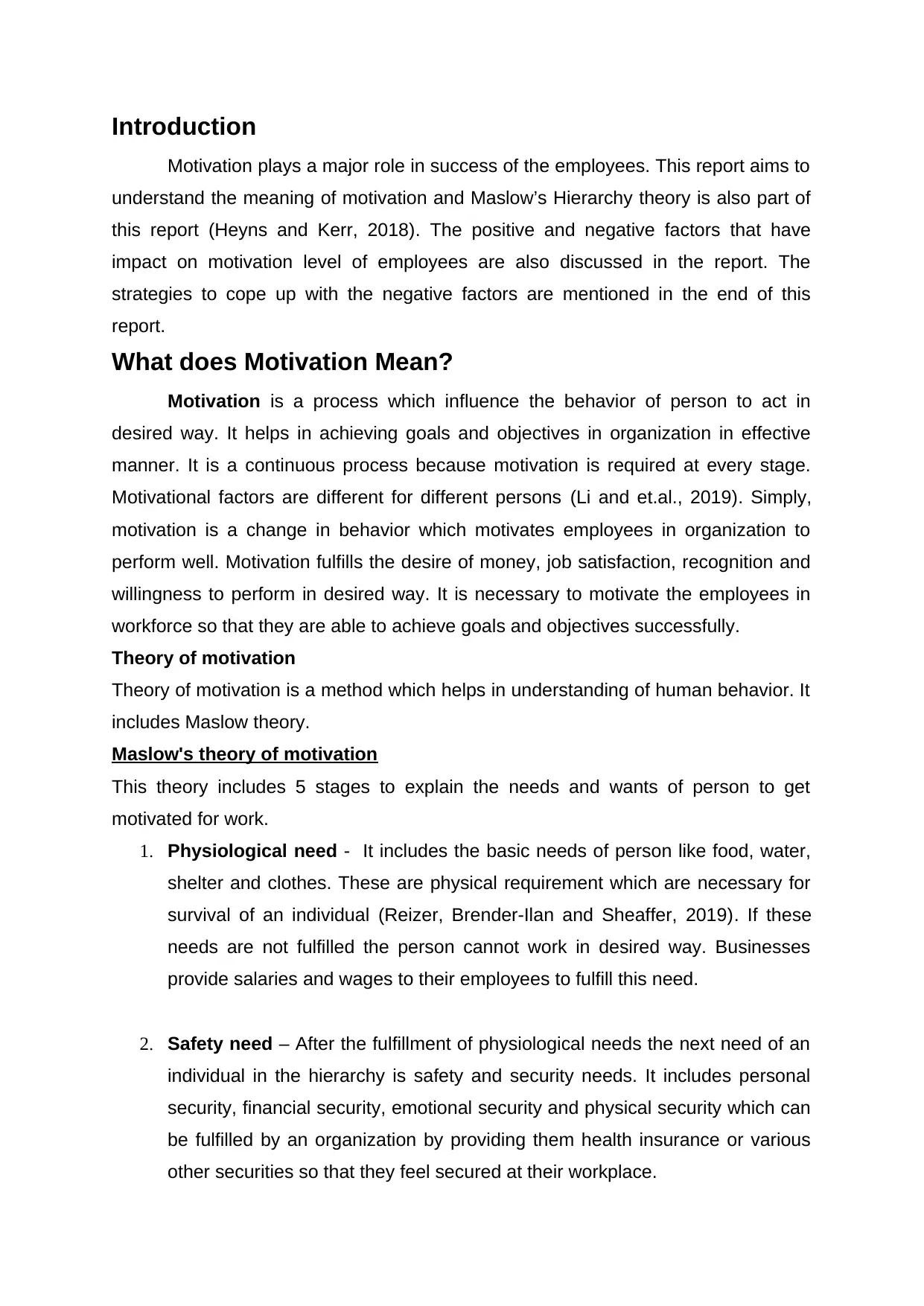
Introduction
Motivation plays a major role in success of the employees. This report aims to
understand the meaning of motivation and Maslow’s Hierarchy theory is also part of
this report (Heyns and Kerr, 2018). The positive and negative factors that have
impact on motivation level of employees are also discussed in the report. The
strategies to cope up with the negative factors are mentioned in the end of this
report.
What does Motivation Mean?
Motivation is a process which influence the behavior of person to act in
desired way. It helps in achieving goals and objectives in organization in effective
manner. It is a continuous process because motivation is required at every stage.
Motivational factors are different for different persons (Li and et.al., 2019). Simply,
motivation is a change in behavior which motivates employees in organization to
perform well. Motivation fulfills the desire of money, job satisfaction, recognition and
willingness to perform in desired way. It is necessary to motivate the employees in
workforce so that they are able to achieve goals and objectives successfully.
Theory of motivation
Theory of motivation is a method which helps in understanding of human behavior. It
includes Maslow theory.
Maslow's theory of motivation
This theory includes 5 stages to explain the needs and wants of person to get
motivated for work.
1. Physiological need - It includes the basic needs of person like food, water,
shelter and clothes. These are physical requirement which are necessary for
survival of an individual (Reizer, Brender-Ilan and Sheaffer, 2019). If these
needs are not fulfilled the person cannot work in desired way. Businesses
provide salaries and wages to their employees to fulfill this need.
2. Safety need – After the fulfillment of physiological needs the next need of an
individual in the hierarchy is safety and security needs. It includes personal
security, financial security, emotional security and physical security which can
be fulfilled by an organization by providing them health insurance or various
other securities so that they feel secured at their workplace.
Motivation plays a major role in success of the employees. This report aims to
understand the meaning of motivation and Maslow’s Hierarchy theory is also part of
this report (Heyns and Kerr, 2018). The positive and negative factors that have
impact on motivation level of employees are also discussed in the report. The
strategies to cope up with the negative factors are mentioned in the end of this
report.
What does Motivation Mean?
Motivation is a process which influence the behavior of person to act in
desired way. It helps in achieving goals and objectives in organization in effective
manner. It is a continuous process because motivation is required at every stage.
Motivational factors are different for different persons (Li and et.al., 2019). Simply,
motivation is a change in behavior which motivates employees in organization to
perform well. Motivation fulfills the desire of money, job satisfaction, recognition and
willingness to perform in desired way. It is necessary to motivate the employees in
workforce so that they are able to achieve goals and objectives successfully.
Theory of motivation
Theory of motivation is a method which helps in understanding of human behavior. It
includes Maslow theory.
Maslow's theory of motivation
This theory includes 5 stages to explain the needs and wants of person to get
motivated for work.
1. Physiological need - It includes the basic needs of person like food, water,
shelter and clothes. These are physical requirement which are necessary for
survival of an individual (Reizer, Brender-Ilan and Sheaffer, 2019). If these
needs are not fulfilled the person cannot work in desired way. Businesses
provide salaries and wages to their employees to fulfill this need.
2. Safety need – After the fulfillment of physiological needs the next need of an
individual in the hierarchy is safety and security needs. It includes personal
security, financial security, emotional security and physical security which can
be fulfilled by an organization by providing them health insurance or various
other securities so that they feel secured at their workplace.
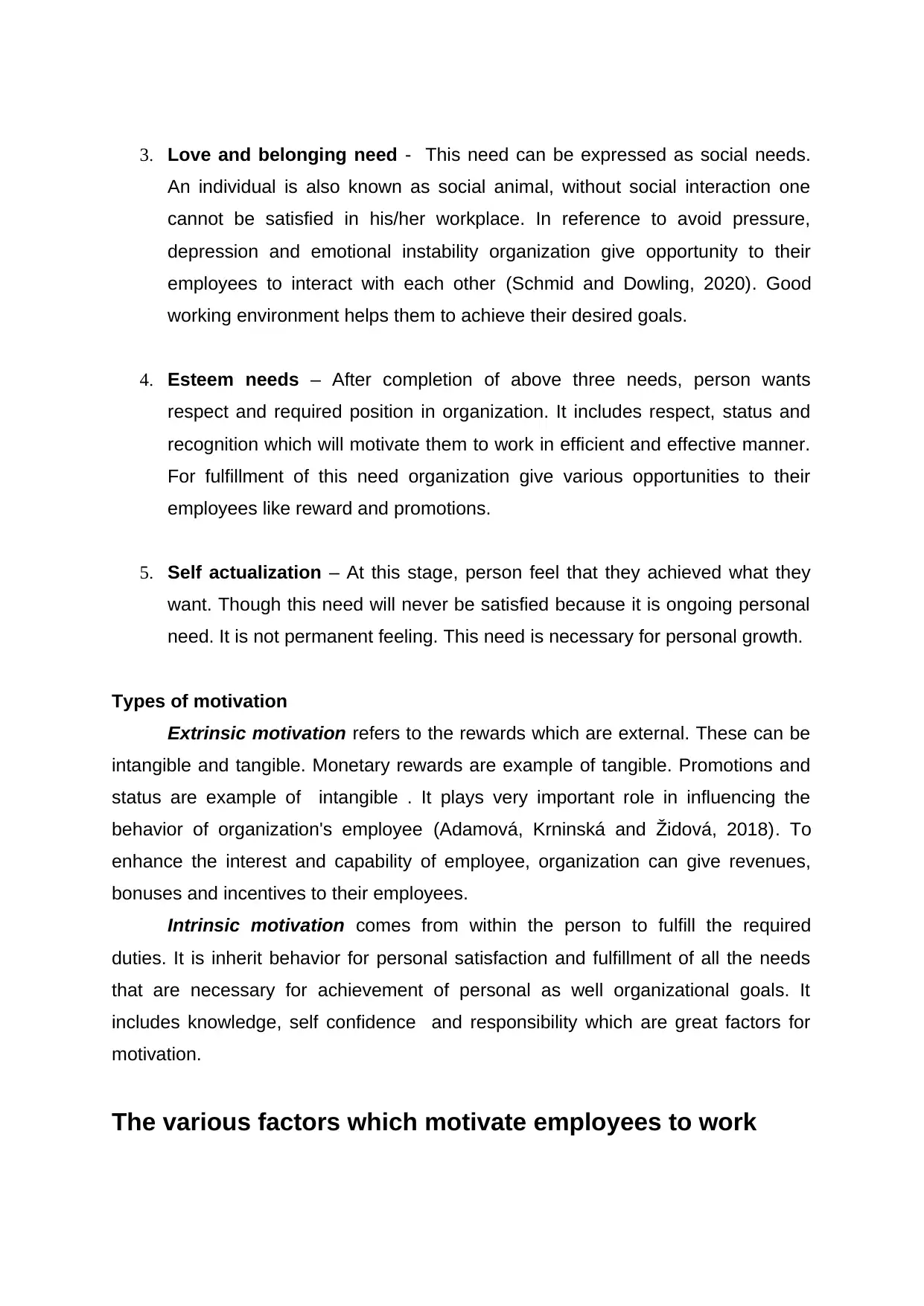
3. Love and belonging need - This need can be expressed as social needs.
An individual is also known as social animal, without social interaction one
cannot be satisfied in his/her workplace. In reference to avoid pressure,
depression and emotional instability organization give opportunity to their
employees to interact with each other (Schmid and Dowling, 2020). Good
working environment helps them to achieve their desired goals.
4. Esteem needs – After completion of above three needs, person wants
respect and required position in organization. It includes respect, status and
recognition which will motivate them to work in efficient and effective manner.
For fulfillment of this need organization give various opportunities to their
employees like reward and promotions.
5. Self actualization – At this stage, person feel that they achieved what they
want. Though this need will never be satisfied because it is ongoing personal
need. It is not permanent feeling. This need is necessary for personal growth.
Types of motivation
Extrinsic motivation refers to the rewards which are external. These can be
intangible and tangible. Monetary rewards are example of tangible. Promotions and
status are example of intangible . It plays very important role in influencing the
behavior of organization's employee (Adamová, Krninská and Židová, 2018). To
enhance the interest and capability of employee, organization can give revenues,
bonuses and incentives to their employees.
Intrinsic motivation comes from within the person to fulfill the required
duties. It is inherit behavior for personal satisfaction and fulfillment of all the needs
that are necessary for achievement of personal as well organizational goals. It
includes knowledge, self confidence and responsibility which are great factors for
motivation.
The various factors which motivate employees to work
An individual is also known as social animal, without social interaction one
cannot be satisfied in his/her workplace. In reference to avoid pressure,
depression and emotional instability organization give opportunity to their
employees to interact with each other (Schmid and Dowling, 2020). Good
working environment helps them to achieve their desired goals.
4. Esteem needs – After completion of above three needs, person wants
respect and required position in organization. It includes respect, status and
recognition which will motivate them to work in efficient and effective manner.
For fulfillment of this need organization give various opportunities to their
employees like reward and promotions.
5. Self actualization – At this stage, person feel that they achieved what they
want. Though this need will never be satisfied because it is ongoing personal
need. It is not permanent feeling. This need is necessary for personal growth.
Types of motivation
Extrinsic motivation refers to the rewards which are external. These can be
intangible and tangible. Monetary rewards are example of tangible. Promotions and
status are example of intangible . It plays very important role in influencing the
behavior of organization's employee (Adamová, Krninská and Židová, 2018). To
enhance the interest and capability of employee, organization can give revenues,
bonuses and incentives to their employees.
Intrinsic motivation comes from within the person to fulfill the required
duties. It is inherit behavior for personal satisfaction and fulfillment of all the needs
that are necessary for achievement of personal as well organizational goals. It
includes knowledge, self confidence and responsibility which are great factors for
motivation.
The various factors which motivate employees to work
Secure Best Marks with AI Grader
Need help grading? Try our AI Grader for instant feedback on your assignments.
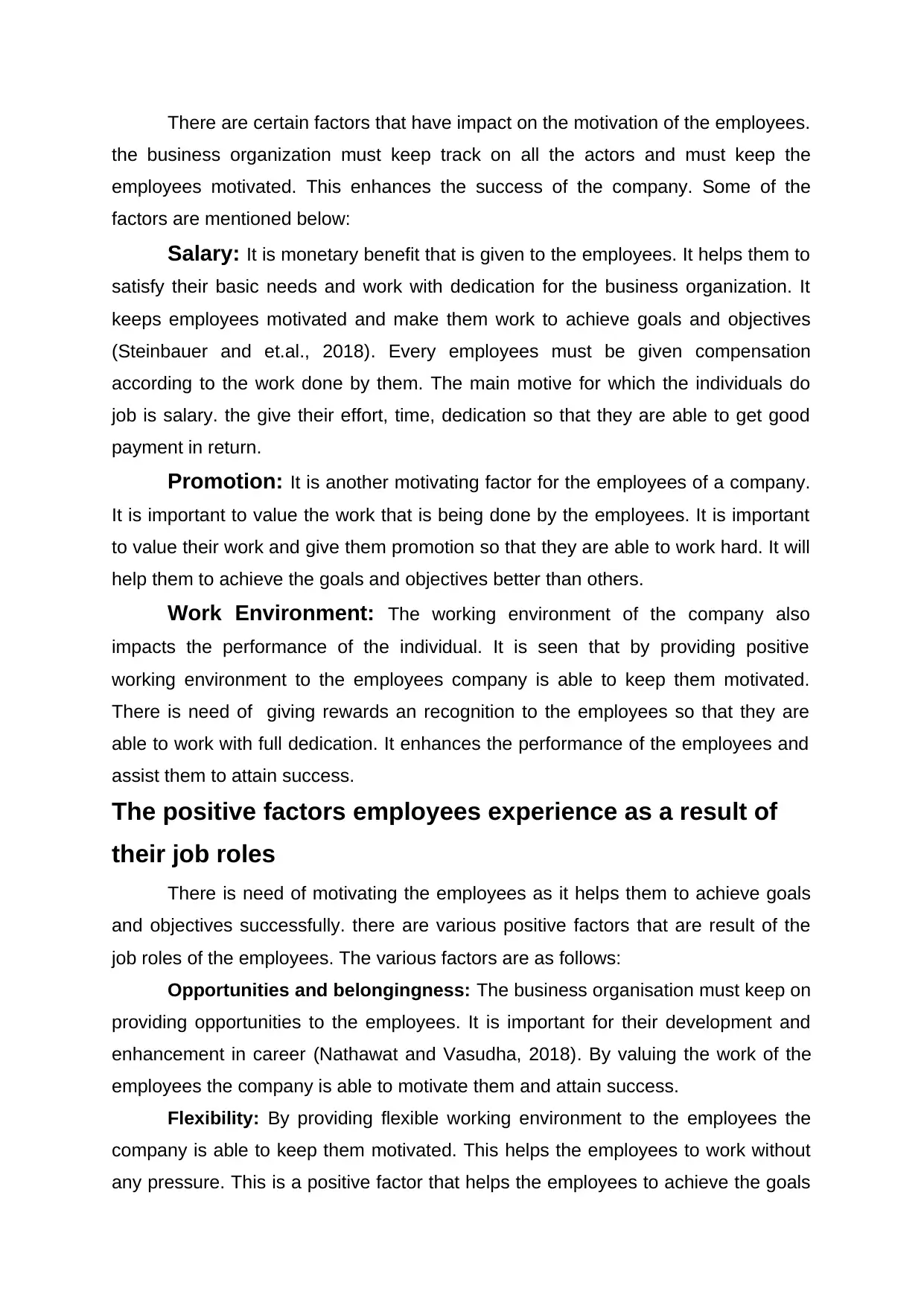
There are certain factors that have impact on the motivation of the employees.
the business organization must keep track on all the actors and must keep the
employees motivated. This enhances the success of the company. Some of the
factors are mentioned below:
Salary: It is monetary benefit that is given to the employees. It helps them to
satisfy their basic needs and work with dedication for the business organization. It
keeps employees motivated and make them work to achieve goals and objectives
(Steinbauer and et.al., 2018). Every employees must be given compensation
according to the work done by them. The main motive for which the individuals do
job is salary. the give their effort, time, dedication so that they are able to get good
payment in return.
Promotion: It is another motivating factor for the employees of a company.
It is important to value the work that is being done by the employees. It is important
to value their work and give them promotion so that they are able to work hard. It will
help them to achieve the goals and objectives better than others.
Work Environment: The working environment of the company also
impacts the performance of the individual. It is seen that by providing positive
working environment to the employees company is able to keep them motivated.
There is need of giving rewards an recognition to the employees so that they are
able to work with full dedication. It enhances the performance of the employees and
assist them to attain success.
The positive factors employees experience as a result of
their job roles
There is need of motivating the employees as it helps them to achieve goals
and objectives successfully. there are various positive factors that are result of the
job roles of the employees. The various factors are as follows:
Opportunities and belongingness: The business organisation must keep on
providing opportunities to the employees. It is important for their development and
enhancement in career (Nathawat and Vasudha, 2018). By valuing the work of the
employees the company is able to motivate them and attain success.
Flexibility: By providing flexible working environment to the employees the
company is able to keep them motivated. This helps the employees to work without
any pressure. This is a positive factor that helps the employees to achieve the goals
the business organization must keep track on all the actors and must keep the
employees motivated. This enhances the success of the company. Some of the
factors are mentioned below:
Salary: It is monetary benefit that is given to the employees. It helps them to
satisfy their basic needs and work with dedication for the business organization. It
keeps employees motivated and make them work to achieve goals and objectives
(Steinbauer and et.al., 2018). Every employees must be given compensation
according to the work done by them. The main motive for which the individuals do
job is salary. the give their effort, time, dedication so that they are able to get good
payment in return.
Promotion: It is another motivating factor for the employees of a company.
It is important to value the work that is being done by the employees. It is important
to value their work and give them promotion so that they are able to work hard. It will
help them to achieve the goals and objectives better than others.
Work Environment: The working environment of the company also
impacts the performance of the individual. It is seen that by providing positive
working environment to the employees company is able to keep them motivated.
There is need of giving rewards an recognition to the employees so that they are
able to work with full dedication. It enhances the performance of the employees and
assist them to attain success.
The positive factors employees experience as a result of
their job roles
There is need of motivating the employees as it helps them to achieve goals
and objectives successfully. there are various positive factors that are result of the
job roles of the employees. The various factors are as follows:
Opportunities and belongingness: The business organisation must keep on
providing opportunities to the employees. It is important for their development and
enhancement in career (Nathawat and Vasudha, 2018). By valuing the work of the
employees the company is able to motivate them and attain success.
Flexibility: By providing flexible working environment to the employees the
company is able to keep them motivated. This helps the employees to work without
any pressure. This is a positive factor that helps the employees to achieve the goals
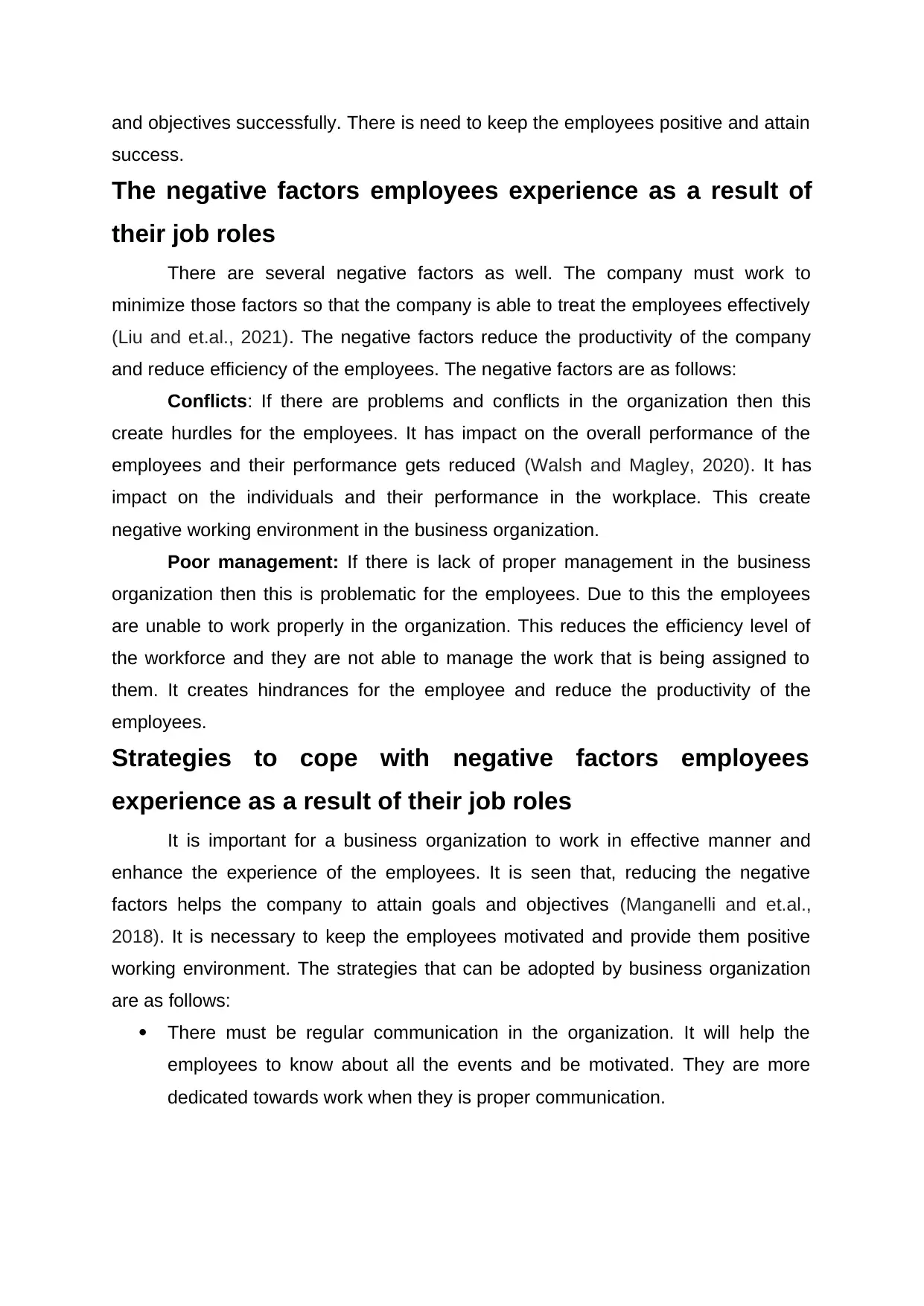
and objectives successfully. There is need to keep the employees positive and attain
success.
The negative factors employees experience as a result of
their job roles
There are several negative factors as well. The company must work to
minimize those factors so that the company is able to treat the employees effectively
(Liu and et.al., 2021). The negative factors reduce the productivity of the company
and reduce efficiency of the employees. The negative factors are as follows:
Conflicts: If there are problems and conflicts in the organization then this
create hurdles for the employees. It has impact on the overall performance of the
employees and their performance gets reduced (Walsh and Magley, 2020). It has
impact on the individuals and their performance in the workplace. This create
negative working environment in the business organization.
Poor management: If there is lack of proper management in the business
organization then this is problematic for the employees. Due to this the employees
are unable to work properly in the organization. This reduces the efficiency level of
the workforce and they are not able to manage the work that is being assigned to
them. It creates hindrances for the employee and reduce the productivity of the
employees.
Strategies to cope with negative factors employees
experience as a result of their job roles
It is important for a business organization to work in effective manner and
enhance the experience of the employees. It is seen that, reducing the negative
factors helps the company to attain goals and objectives (Manganelli and et.al.,
2018). It is necessary to keep the employees motivated and provide them positive
working environment. The strategies that can be adopted by business organization
are as follows:
There must be regular communication in the organization. It will help the
employees to know about all the events and be motivated. They are more
dedicated towards work when they is proper communication.
success.
The negative factors employees experience as a result of
their job roles
There are several negative factors as well. The company must work to
minimize those factors so that the company is able to treat the employees effectively
(Liu and et.al., 2021). The negative factors reduce the productivity of the company
and reduce efficiency of the employees. The negative factors are as follows:
Conflicts: If there are problems and conflicts in the organization then this
create hurdles for the employees. It has impact on the overall performance of the
employees and their performance gets reduced (Walsh and Magley, 2020). It has
impact on the individuals and their performance in the workplace. This create
negative working environment in the business organization.
Poor management: If there is lack of proper management in the business
organization then this is problematic for the employees. Due to this the employees
are unable to work properly in the organization. This reduces the efficiency level of
the workforce and they are not able to manage the work that is being assigned to
them. It creates hindrances for the employee and reduce the productivity of the
employees.
Strategies to cope with negative factors employees
experience as a result of their job roles
It is important for a business organization to work in effective manner and
enhance the experience of the employees. It is seen that, reducing the negative
factors helps the company to attain goals and objectives (Manganelli and et.al.,
2018). It is necessary to keep the employees motivated and provide them positive
working environment. The strategies that can be adopted by business organization
are as follows:
There must be regular communication in the organization. It will help the
employees to know about all the events and be motivated. They are more
dedicated towards work when they is proper communication.
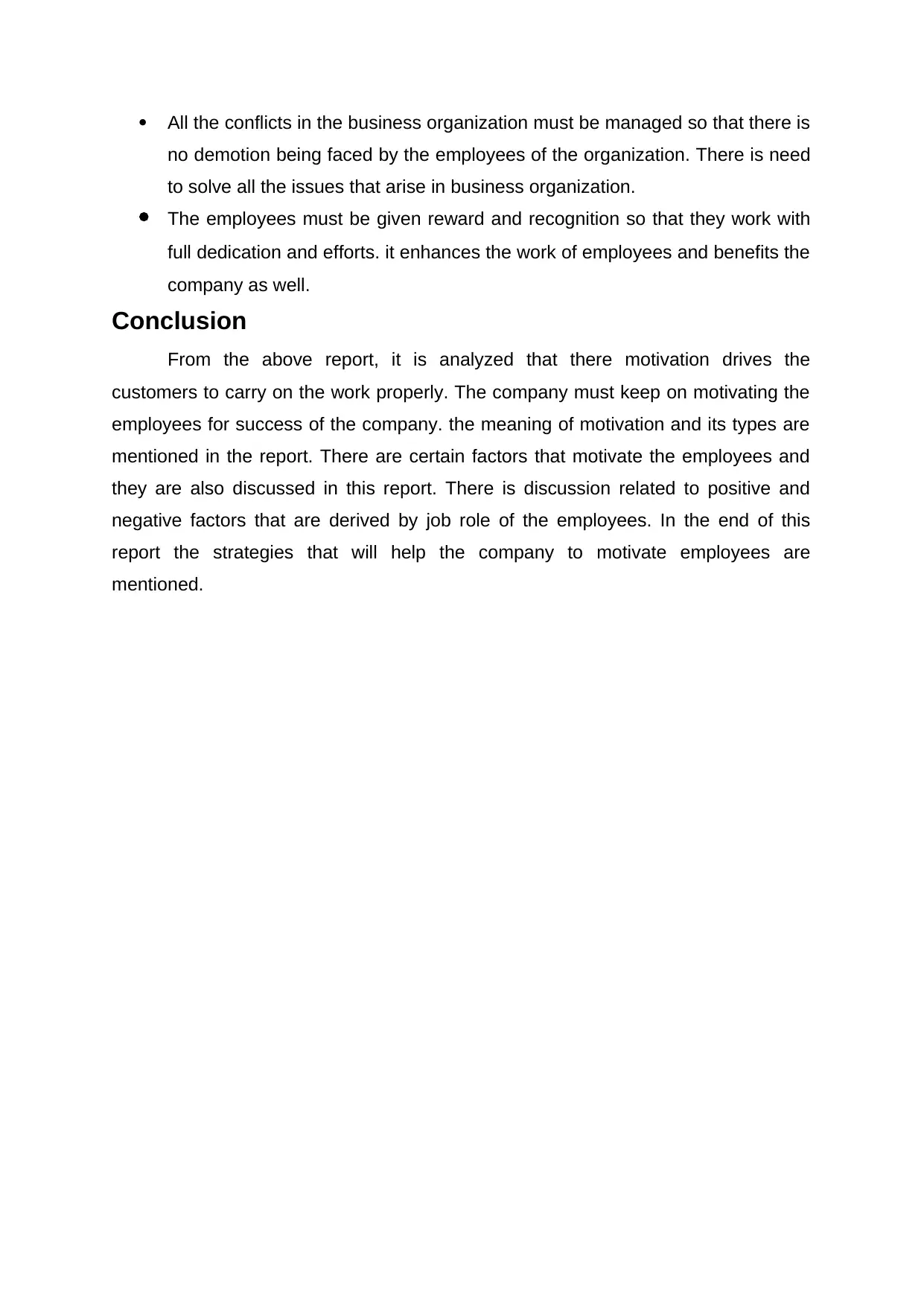
All the conflicts in the business organization must be managed so that there is
no demotion being faced by the employees of the organization. There is need
to solve all the issues that arise in business organization.
The employees must be given reward and recognition so that they work with
full dedication and efforts. it enhances the work of employees and benefits the
company as well.
Conclusion
From the above report, it is analyzed that there motivation drives the
customers to carry on the work properly. The company must keep on motivating the
employees for success of the company. the meaning of motivation and its types are
mentioned in the report. There are certain factors that motivate the employees and
they are also discussed in this report. There is discussion related to positive and
negative factors that are derived by job role of the employees. In the end of this
report the strategies that will help the company to motivate employees are
mentioned.
no demotion being faced by the employees of the organization. There is need
to solve all the issues that arise in business organization.
The employees must be given reward and recognition so that they work with
full dedication and efforts. it enhances the work of employees and benefits the
company as well.
Conclusion
From the above report, it is analyzed that there motivation drives the
customers to carry on the work properly. The company must keep on motivating the
employees for success of the company. the meaning of motivation and its types are
mentioned in the report. There are certain factors that motivate the employees and
they are also discussed in this report. There is discussion related to positive and
negative factors that are derived by job role of the employees. In the end of this
report the strategies that will help the company to motivate employees are
mentioned.
Paraphrase This Document
Need a fresh take? Get an instant paraphrase of this document with our AI Paraphraser
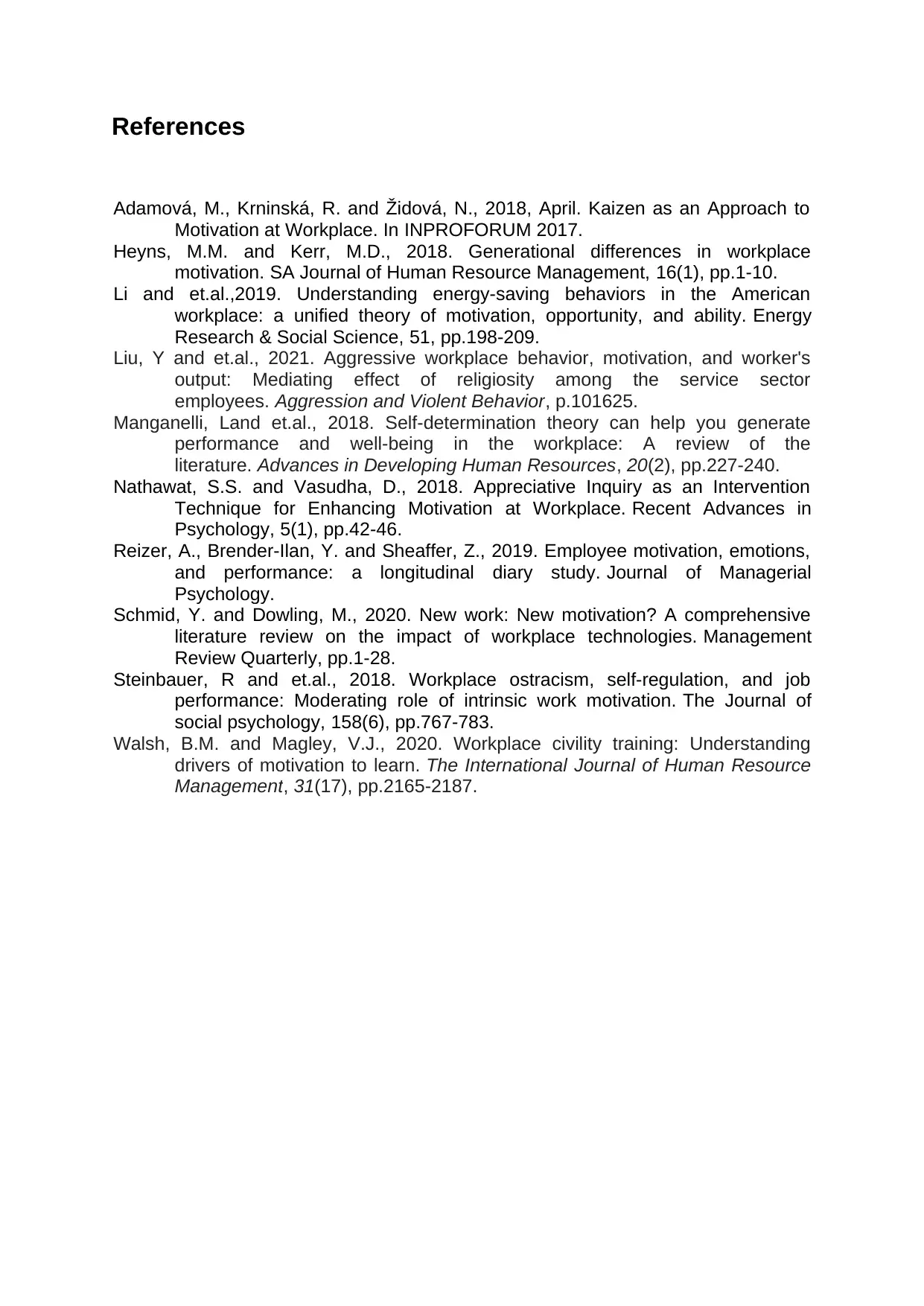
References
Adamová, M., Krninská, R. and Židová, N., 2018, April. Kaizen as an Approach to
Motivation at Workplace. In INPROFORUM 2017.
Heyns, M.M. and Kerr, M.D., 2018. Generational differences in workplace
motivation. SA Journal of Human Resource Management, 16(1), pp.1-10.
Li and et.al.,2019. Understanding energy-saving behaviors in the American
workplace: a unified theory of motivation, opportunity, and ability. Energy
Research & Social Science, 51, pp.198-209.
Liu, Y and et.al., 2021. Aggressive workplace behavior, motivation, and worker's
output: Mediating effect of religiosity among the service sector
employees. Aggression and Violent Behavior, p.101625.
Manganelli, Land et.al., 2018. Self-determination theory can help you generate
performance and well-being in the workplace: A review of the
literature. Advances in Developing Human Resources, 20(2), pp.227-240.
Nathawat, S.S. and Vasudha, D., 2018. Appreciative Inquiry as an Intervention
Technique for Enhancing Motivation at Workplace. Recent Advances in
Psychology, 5(1), pp.42-46.
Reizer, A., Brender-Ilan, Y. and Sheaffer, Z., 2019. Employee motivation, emotions,
and performance: a longitudinal diary study. Journal of Managerial
Psychology.
Schmid, Y. and Dowling, M., 2020. New work: New motivation? A comprehensive
literature review on the impact of workplace technologies. Management
Review Quarterly, pp.1-28.
Steinbauer, R and et.al., 2018. Workplace ostracism, self-regulation, and job
performance: Moderating role of intrinsic work motivation. The Journal of
social psychology, 158(6), pp.767-783.
Walsh, B.M. and Magley, V.J., 2020. Workplace civility training: Understanding
drivers of motivation to learn. The International Journal of Human Resource
Management, 31(17), pp.2165-2187.
Adamová, M., Krninská, R. and Židová, N., 2018, April. Kaizen as an Approach to
Motivation at Workplace. In INPROFORUM 2017.
Heyns, M.M. and Kerr, M.D., 2018. Generational differences in workplace
motivation. SA Journal of Human Resource Management, 16(1), pp.1-10.
Li and et.al.,2019. Understanding energy-saving behaviors in the American
workplace: a unified theory of motivation, opportunity, and ability. Energy
Research & Social Science, 51, pp.198-209.
Liu, Y and et.al., 2021. Aggressive workplace behavior, motivation, and worker's
output: Mediating effect of religiosity among the service sector
employees. Aggression and Violent Behavior, p.101625.
Manganelli, Land et.al., 2018. Self-determination theory can help you generate
performance and well-being in the workplace: A review of the
literature. Advances in Developing Human Resources, 20(2), pp.227-240.
Nathawat, S.S. and Vasudha, D., 2018. Appreciative Inquiry as an Intervention
Technique for Enhancing Motivation at Workplace. Recent Advances in
Psychology, 5(1), pp.42-46.
Reizer, A., Brender-Ilan, Y. and Sheaffer, Z., 2019. Employee motivation, emotions,
and performance: a longitudinal diary study. Journal of Managerial
Psychology.
Schmid, Y. and Dowling, M., 2020. New work: New motivation? A comprehensive
literature review on the impact of workplace technologies. Management
Review Quarterly, pp.1-28.
Steinbauer, R and et.al., 2018. Workplace ostracism, self-regulation, and job
performance: Moderating role of intrinsic work motivation. The Journal of
social psychology, 158(6), pp.767-783.
Walsh, B.M. and Magley, V.J., 2020. Workplace civility training: Understanding
drivers of motivation to learn. The International Journal of Human Resource
Management, 31(17), pp.2165-2187.
1 out of 8
Related Documents
Your All-in-One AI-Powered Toolkit for Academic Success.
+13062052269
info@desklib.com
Available 24*7 on WhatsApp / Email
![[object Object]](/_next/static/media/star-bottom.7253800d.svg)
Unlock your academic potential
© 2024 | Zucol Services PVT LTD | All rights reserved.


